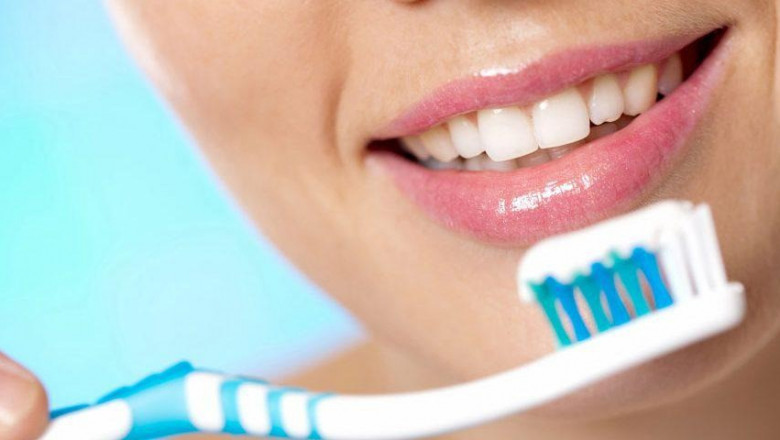views
Understanding Pain After Teeth Cleaning
Teeth cleaning is a standard procedure that involves the removal of plaque, tartar, and debris from the surface of your teeth and gums. For most people, this process is quick and relatively painless. However, some individuals may experience mild to moderate pain after a teeth cleaning, especially if their teeth are sensitive or they have gum inflammation. The discomfort typically results from the pressure applied during cleaning or from the removal of tartar near the gum line, which can irritate the gums.
The pain is often temporary and usually resolves within a few hours to a couple of days. However, if you are someone who experiences heightened sensitivity, you may wonder how to relieve pain after teeth cleaning effectively. There are several methods to alleviate the discomfort and ensure you can continue with your daily routine without too much interruption.
Tips for Relieving Pain After Teeth Cleaning
-
Use Over-the-Counter Pain Relievers
One of the quickest and most effective ways to manage discomfort after a teeth cleaning session is by using over-the-counter (OTC) pain relievers. Medications like ibuprofen or acetaminophen can help reduce inflammation and alleviate pain. Be sure to follow the recommended dosage instructions on the package to avoid any adverse effects. If the pain persists or worsens, it’s always a good idea to consult with your dentist.
-
Avoid Hot and Cold Foods and Drinks
After a cleaning, your teeth and gums might be sensitive, especially if your cleaning was extensive. To minimize discomfort, it’s advisable to avoid consuming hot or cold foods and beverages immediately after the procedure. These temperature extremes can cause sharp pain if your teeth are sensitive. Sticking to room-temperature foods and drinks can help prevent irritation and allow your teeth and gums to heal more comfortably.
-
Rinse with Warm Saltwater
Rinsing your mouth with warm saltwater is an old and effective remedy for soothing irritated gums and reducing inflammation. Salt has natural antibacterial properties that can help to cleanse the mouth and reduce the risk of infection. Mix a teaspoon of salt in a glass of warm water and rinse gently for 30 seconds to 1 minute. This simple solution can offer immediate relief and promote healing.
-
Use a Toothpaste for Sensitive Teeth
If you know that you have sensitive teeth, it’s a good idea to switch to a toothpaste designed specifically for this condition. These types of toothpaste contain compounds that help block the pathways that lead to nerve sensitivity. Using a toothpaste for sensitive teeth both before and after a cleaning can significantly reduce the discomfort you experience during and after the procedure.
-
Apply a Cold Compress
A cold compress can be another simple and effective way to relieve pain and swelling in the areas around your gums and teeth. Applying a cold compress to the outside of your mouth can reduce inflammation and numb the pain temporarily. Simply wrap some ice in a cloth or use a cold gel pack, and apply it to your cheek near the affected area for 15-20 minutes at a time. Be sure to give your skin breaks in between to avoid irritation.
-
Avoid Smoking and Tobacco Products
If you smoke or use tobacco products, it’s advisable to refrain from these habits after a teeth cleaning. Smoking can irritate your gums and delay the healing process. Additionally, tobacco products can introduce harmful bacteria into your mouth, which can increase the risk of infections or complications post-cleaning.
When to Seek Professional Help
While the majority of pain following a teeth cleaning is temporary and manageable, it’s important to monitor your symptoms. If you experience severe or prolonged pain, swelling, or bleeding, it could indicate an underlying issue, such as an infection or gum disease. In such cases, you should reach out to your dentist for further evaluation.
If your pain extends beyond routine discomfort and involves deeper issues, like a tooth infection or significant decay, your dentist may recommend treatments such as a root canal. Root canals are necessary when the pulp inside a tooth becomes infected or damaged. While many people fear root canals, the procedure is often essential for saving a tooth and alleviating pain. If you find yourself in need of a root canal, it’s worth exploring cheap root canal options available in your area.
Affordable Root Canal Treatments
For those who require a root canal, the cost of the procedure can be a concern. However, affordable root canal options are available, ensuring that you don’t have to sacrifice quality care due to financial limitations. Many dental offices offer payment plans, discounts, or financing options to help patients manage the cost of root canal treatments. You can also check for local dental providers who specialize in providing cost-effective treatments without compromising on quality.
For residents in Houston, for instance, Mobile Dental Associates offers affordable root canal treatments without breaking the bank. Their services are designed to ensure that patients receive the necessary care at a price they can afford, without having to worry about excessive costs. Their experienced team can guide you through the process, making sure you understand the treatment options and payment plans available to you. You can learn more about these options by visiting their website at affordable root canal Houston.
Conclusion
Experiencing pain after teeth cleaning is common, but there are several ways to relieve discomfort and ensure a smoother recovery. From using over-the-counter pain relievers to avoiding certain foods, these simple steps can help you feel more comfortable as your gums heal. Additionally, if you find yourself in need of more advanced treatments, like a root canal, it’s important to know that affordable options are available to meet your needs. Maintaining good oral health through regular cleanings and addressing any dental concerns promptly is the key to a healthy, pain-free smile.














Comments
0 comment